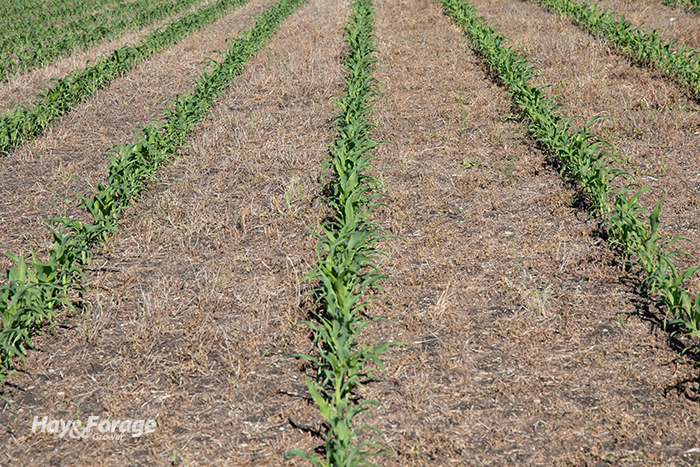
Grazing fall cornstalks is a common practice throughout the Midwest and Great Plains. But what if we could improve that brown crop residue with green and growing forage?
Interseeding annual forages between corn rows will provide a high-quality forage for cattle that are needing to put on weight such as stockers or weaned calves. The Cadillac approach to interseeding is to widen corn rows and drill annual forages between the rows, but farmers have also been successful by broadcasting seed and then doing a light harrowing between rows. Fields that are under irrigation have a decisive advantage as moisture is a key variable to seeding success.
University of Nebraska Extension educators Alfredo DiCostanzo and Connor Biehler offered their recommendations for successfully implementing an interseeding strategy in a recent BeefWatch newsletter. They suggest choosing an early maturing corn hybrid to maximize the time cattle can spend grazing the mixture of forage and cornstalks. Fields that are targeted for an earlage or high-moisture corn harvest make good candidates for interseeding.
They also emphasize the importance of being familiar with the labels of the chemicals that have been and will be applied to the field. This is important for two reasons: to ensure previous chemicals won’t inhibit forage crop germination and growth and to eliminate the possibility of chemical residues in animal meat or organs.
DiCostanzo and Biehler recommend seeding the forage crop when corn is in the three- to five-leaf stage. This can be done using a high-clearance drill or aerially. Typically, a forage mixture is seeded that can include cereal grains, clovers, and/or brassicas.
To get the most out of grazing an interseeded crop, the extension educators suggest strip grazing. This will result in the best utilization and extend the grazing season for a longer period into the fall compared to just opening the gate and letting cattle roam the entire field.
Run the numbers
DiCostanzo and Biehler cite a recent study done on commercial dryland cornfields where the yield difference between planting corn in 30-inch versus 60-inch rows was 33 bushels (bu) per acre. The corn in 30-inch rows yielded 185 bu per acre. At current corn grain prices ($4.50 per bu), the interseeded forage in 60-inch rows resulted in a reduction in revenue of roughly $150 per acre. At current calf prices at $3.50 per pound, the grazing gains of 40 pounds per acre would offset this reduction in lower grain revenue from the 60-inch corn.
In the study, interseeding forage between 60-inch corn rows resulted in nearly 900 pounds of forage dry matter per acre. Assuming a modest conversion of forage-to-beef gain of 10 pounds to 1 pound, this results in 90 pounds of gain per acre, which is twice the amount of gain needed to offset lower grain yields. These calculations do not consider the differential in costs resulting from less seed corn and the cost of the forage seed.

